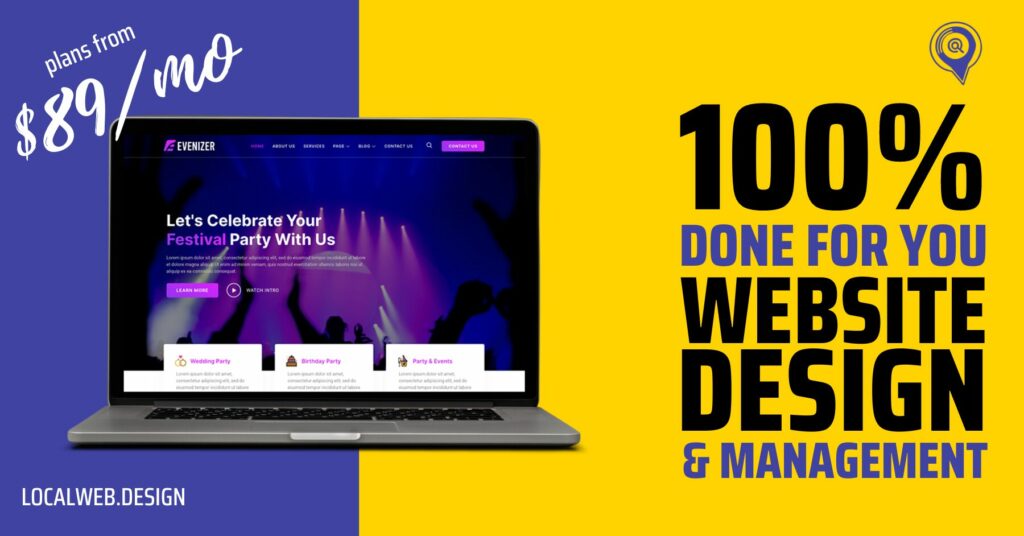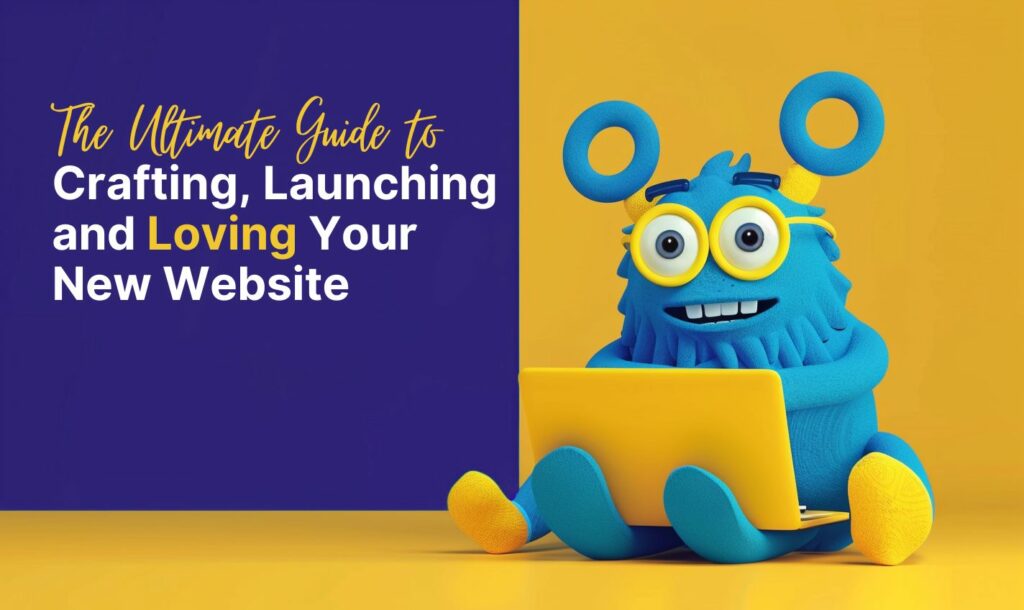Thinking about making your own website but not sure where to start? You’re in the right place! We’re diving into the nitty gritty of website creation, step by step. Welcome to the ground zero of your website design journey!
Planning Makes Perfect!
It goes without saying that building the perfect website takes a lot of preparation but understanding your purpose, the visitors who will come to your site, and the technical process of finding and securing a domain and hosting will help you get your website design off to a great start. The path to a fun and rewarding experience lies in creating the foundation for success with preparation and a little work.
But don’t worry. If this all seems a little too much, we’ll give you some alternative options for easily building your website. I mean, hey, web design is what we do, so we are going to have a little shameless plug (or two) in here somewhere.
Understanding Your Website Design & Purpose
You may know you want to build a website, but have you first thought about what you’d like to achieve with your new website? Are you looking to reach more customers, educate and share insights about something you are passionate about, give back by creating a community service, sell e-commerce products in an online store, start a blog, or showcase a portfolio?
The first step is understanding and clarifying your mission. It’s important to be specific and realistic because setting achievable, measurable goals will not only guide you in the development process but also give you little “wins” you’ll be able to celebrate along the way.
Grab a piece of paper and see if you can answer the following two questions:
- What is my website’s mission?
- What achievable goals can I set to create an action plan for my website’s success?
Knowing Your Audience
This is an important one but also typically one of the biggest challenges for most people, so we’d urge you to spend some time on it. It’s important to create detailed profiles for each segment of your audience. What are their ages, interests, and web browsing behaviors?
If you are already selling a product or have a successful business, you may already have an idea of who will visit your website. Remember that depending on your industry or service, the profile of your web visitor may be slightly different.
What social platforms are your ideal clients on? Are they tech-savvy? What type of content do they consume? Will they be familiar with your product when they arrive or will they just be learning about it? What are their pain points? Equally important: who is not an ideal client?
Some people like to call this building their ideal client or website visitor avatars. When you start building your website design, you’ll want to tailor your site content and design to meet the needs and preferences of your personas. Check out this Simple 4 Step Process to Create Accurate User Personas from Hotjar.
Following along with the article from Hotjar, break out that notepad again and create a table with 4 columns.
- In column one, identify the broad, general category of your ideal visitor or customer.
- In column two, narrow down this broad category to a more specific sub-audience.
- In column 3, write down the main goal these users have for visiting your site.
- In column 4, write down the barriers they face to achieving their goals.
At LocalWeb.Design we could answer these questions as follows:
- Who is our ideal website visitor? Someone who needs a website.
- More specifically, this group includes small business owners and entrepreneurs who need to build their online presence or shift away from self-managing their websites.
- What do they want? They want to attract more customers with a professional website design and effectively manage their time so that they can focus on running their business.
- Why don’t they have it? They operate a growing business or organization. Do-it-yourself isn’t an option because they are either too busy or lack the technical expertise to build and manage the site themselves. They understand the value of delegating tasks to direct their focus on continual business growth. They may be on the path to a larger digital strategy, but they either don’t have the capital to invest in a full digital agency relationship or they aren’t currently in a situation that requires a super complicated website. They need an affordable done-for-you turnkey website that doesn’t take them away from their other goals.
See how awesome that is? Narrowing down and identifying your ideal customer or website visitor can help you deliver a product, service, and website they find valuable. Armed with this information, you now have a blueprint for how to attract and engage your audience. Congratulations!
Choosing a Domain Name
Now it’s time to let your creative juices flow. Picking out your domain name can be a fun exercise, but there are some important things to keep in mind.
There are currently around 350 million registered domains worldwide. That equates to about one domain for every 22 people. No wonder the domain industry’s estimated worth is $7 billion dollars in the United States alone. What does this mean for you? Be prepared that your ideal domain may not be available, so don’t get discouraged. Keep looking and you’ll find one that works for you, or you may find your ideal domain and have to spend a little extra to secure it.
Key points to remember when choosing a domain name:
- Memorable and concise: Pick a domain that is easy to remember, pronounce, and spell.
- Relevant to your content: Ensure it reflects your business and is easy to connect with your mission.
- SEO-friendly: You may even decide to incorporate keywords that improve your visibility in search engines.
Structuring Your Site
Before you begin building your site, take a moment to outline the pages and content you want to feature on your new website. This stage will not only help you organize your content into a logical navigation flow, but it will also serve as the basis for building out the wireframes for content and website design.
Wireframes are stripped-down outlines of your site’s pages. These useful tools in website creation help you ensure the proper placement of key elements of your design and content. Remember to keep all of your relevant calls to action highly visible on the page.
- Sitemap creation: Outline the main pages and categories. Think about the journey you want visitors to take.
- Prioritize usability: The easier your site is to navigate, the longer visitors will stay, and the easier it will be for search bots to crawl your site and understand the content for indexing.
Designing Your Dream Site
Welcome to the heart of website aesthetics and functionality! Let’s delve deeper into crafting a design that not only looks great but also enhances user experience.

Optimizing User Interface (UI) and User Experience (UX)
When creating your new website design, focus on clean layouts that avoid clutter. Use white space effectively to draw attention to key elements. Additionally, ensure your color schemes, fonts, and all website design elements are consistent across all pages to reinforce brand identity.
Besides an easily navigable and brand-consistent website, there are other considerations, including ADA compliance and mobile usability (size of copy, spacing of clickable elements, etc).
Ensure your website is accessible to all users, including those with disabilities. This includes color contrast, text size, and navigational ease. There are some great tools available, like the Accessibe site overlay, which can be added to your website to help automatically modify your content for users with visual, cognitive, and motor disabilities.
Choosing the Right Website Design & Theme
Whether you design a fully custom website or use a website template, you’ll want a design that embodies your brand’s personality, messaging, and values. Choose themes that are mobile-friendly and look great on any device. Remember that most of your website visitors will likely be on mobile devices, so it’s important to ensure your site is responsive.
Visual Content that Engages
The visuals (videos, photos, graphics, infographics, and icons) on your site can take a website design from good to great. Use high-quality images and videos that capture your message and engage users. Explain complex information with infographics and use icons to highlight important content visually.
When selecting images and graphics for your site, remember to consider load time. Utilize video streaming services, web formats like WebP for images, compressed file sizes, and caching to reduce server overhead and improve load times. Your site’s speed not only improves the user experience but can also significantly impact your search rankings.
Building Blocks of Your Website
Creating a website involves choosing the right platforms and tools. Let’s explore how to select these tools and the key components of building a robust website.
Choosing a Website Builders and Content Management Systems (CMS)
There are many platforms for building your website. While some websites are built in pure HTML or another coding language, there are website builders that can make the process of managing the website easier. Some of these platform options include WordPress, Wix, Squarespace, and Shopify.
Each platform has its own strengths and weaknesses, though WordPress stands out as the leader in functionality, flexibility, and integrability. Dominating the CMS market with a 62.8% market share and over 472 million (43.3% of all) websites powered by WordPress, it’s no wonder it’s supported by over 30,000 themes and 60,000 plugins that help you achieve just about anything you need with your website.
What Website Service is Best?
There is no one-size-fits-all when it comes to website development. Every business has different needs, requires different technology, and has varying budgets.
Here are three of the most common scenarios for business website design:
- DIY Websites ($16-$120/mo): Consider simple platforms for hobbyists and sites that aren’t mission-critical. Some options, like Squarespace and Wix, allow you to “Do It Yourself” and are great for those on a budget who have the time, patience, and tech knowledge to build and manage the site solo. These sites won’t give you all the flexibility of more robust platforms like WordPress, but they are a solid cheap option for some. You can also DIY your own WordPress site, which we’ll share in a later post.
- DFY Websites ($89-$189/mo): For growing companies and busy owners, a done-for-you service like LocalWeb.Design offers turnkey design and management solutions for a low monthly subscription to small businesses. At LocalWeb.Design, we build all of our websites on WordPress because it’s the most robust system and offers the most flexibility for most of our clients. As one of the most popular and customizable website platforms with just under 60,000 third-party API integrations, WordPress has the flexibility to grow* with your company.
- Agency Websites ($15,000 – $100,000+): As businesses grow, their digital needs become more complex. At this point, a larger agency can provide strategic direction, design, automation, and other technologies to help with complex enterprise sites. Almost half of all websites, even agency sites, are powered by WordPress*.
* If you are a small or mid-size company, it’s important to keep this flexibility in mind. Most budget platforms like Wix and Squarespace operate on a different technology than WordPress and often require a complete rebuild.
Adding and Managing Content
You’ll want to keep your site updated with new content. This can include updating your service offerings, adding specials, industry-related news, and blog posts. Keeping your content fresh and updated will not only increase your visitors’ engagement but also result in Google and other search bots crawling your site more frequently.
Integrations and Plugins
As mentioned previously there are over 60,000 plugins for WordPress allowing integrations with a range of services like Salesforce, Monday.com, Hubspot, Mailchimp, and others. Pro Tip: In the unlikely event you can’t find a direct integration with WordPress or a plugin, you can utilize services like Zapier which bridges integration between multiple WordPress plugins and other third-party services.
Ready, Set, Launch
Launching your website is a thrilling moment! If you’ve made it this far, it’s time to review everything and make sure you are all set for a successful launch.

Pre-Launch Testing
You have all of your website design elements, content, optimized images, functional navigation, calls to action, forms, plugins and other integrations in place. Now you’ll want to do some testing to make sure everything works as expected.
Verify that forms submit properly and are delivered to the appropriate team members or mailing lists. Check that all of the pages load and links aren’t broken. There are some great plugins, like Broken Link Checker by WPMU Dev who also make other great plugins, which can help you identify broken links throughout your site.
Check your site on multiple devices and web browsers to ensure it loads properly and displays as intended. Keep in mind that a mobile-friendly website will display differently on a mobile device than on a desktop. This is expected behavior and should be optimized for ease of use on all platforms.
Check that your site is loading quickly. You can use tools like Google’s PageSpeedInsights to test the speed of your site on desktop and mobile. Use caching plugins like WPRocket which speed up your site by compressing files.
You can also use a content delivery network (CDN) to speed up the website load times. If you are using WPRocket for caching you can easily integrate with their CDN services in a few clicks, or utilize other popular CDN services like Cloudflare.
What is a content delivery network? A content delivery network creates cached copies of your site that are served from different data facilities. These facilities are geographically located allowing your site files to be served from a server closest to your website visitors for faster load times.
Have your family and friends test out your site as well to see if they have any suggestions or issues that should be remedied before going live.
SEO and Analytics Setup
Check your content to make sure it’s optimized using basic SEO strategies like meta tags, keywords and alt text for images. Alt text is used by screenreaders for visitors with disabilities and also by Google to better understand your page content. Remember that SEO isn’t a set-it-and-forget-it aspect of web design. Once you’ve launched your site, you’ll want to monitor results and continue to optimize.
This brings us to the next step: Analytics Tracking. You can use free tools like Google Analytics to monitor website traffic and visitor behavior. You can even set conversion goals and monitor sales on your website. Analytics works seamlessly with other services like Google Ads or social media ads to help make tracking Return On Investment (ROI) of your campaigns easier.
Going Live
If you are redesigning a website, choose a low-traffic time for your launch to manage any unforseen issues smoothly. You may also want to prepare social media posts, emails, and other promotional materials to announce the launch.
Once the site is up, make sure to submit your sitemap to search engines using Google Search Console so Google and other search engines can easily find your website. Tip: Make sure to check that your site is indexable. In WordPress, you can find this under the Settings > Reading panel within the administration panel.

After the Launch Party
After launching your website, the journey doesn’t end—it’s just beginning! Here’s how to keep your site performing well and engaging visitors long term:
Post-Launch Monitoring
Regularly check your load times, functionality and user behavior to ensure everything is running smoothly. You can use heatmap tools like Hotjar or Aurora to see how users are interacting with your content. Use this information to make adjustments to your content to improve usability and engagement on your CTAs.
Ongoing SEO and Content Updates
As mentioned earlier, make sure to regularly update your blogs, articles and pages to keep your content fresh and engaging for return visitors. Additionally, you may want to implement more complex SEO tactics like link building and keyword optimization to help you rank higher in search engines and attract more engaged visitors.
Regular Maintenance
In order to keep your website secure and running smoothly, you’ll want to regularly update your site’s core CMS and plugins. You are dealing with a significant amount of data. On the backend of a website there can be thousands of files, so keeping your website updated and backed up is important. Implement regular backup procedures to prevent data loss.
Wrapping It Up!
Hopefully, this article has helped you better understand the process of crafting, launching and loving your new website.
Need More Help?
Of course, we know this can be a lot to take in. If you aren’t a DIYer, or if you just want to enjoy the site without all of the hassle of building it yourself, check out our super affordable website design and maintenance services at LocalWeb.Design. We offer a low monthly subscription website design and maintenance service starting at just $89/month. We handle everything from design to launch, so you can enjoy all the benefits without the sweat equity.

We even offer add-on services like search engine optimization and pay per click. Check out our features or get started today!
Already have a website? We can manage that too. Check out our maintenance plans for existing websites.
If you have questions, feel free to reach out to our friendly support!


